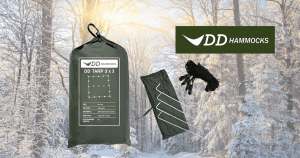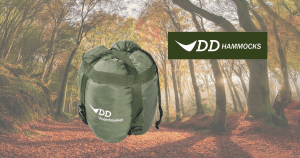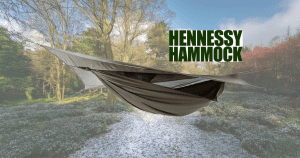Exploring the great outdoors is one of the best ways to disconnect from the daily grind and reconnect with nature. But even the most picturesque hikes and peaceful campsites come with their share of risks, and having a well-stocked first aid kit is a crucial part of any outdoor adventure. Whether you’re a weekend hiker or an experienced wild camper, a proper First Aid Kits for Hiking and Wild Camping can mean the difference between a minor inconvenience and a serious situation.
In this guide, we’ll cover everything you need to know about building or buying a first aid kit for hiking and wild camping in the UK, including essential supplies, tips for handling common injuries, and some top picks for kits that can keep you safe in the wilderness.
Why You Need a First Aid Kit for Hiking and Wild Camping
When you’re miles away from the nearest pharmacy or emergency room, even a small injury can quickly escalate without the right care. Hiking and camping present unique risks, from twisted ankles on rocky trails to blisters from new boots or even mild allergic reactions to unexpected plant life. A proper first aid kit is your peace of mind, ensuring that you’re equipped to handle minor injuries, manage discomfort, and even stabilise a serious condition until professional help arrives.
Key Features to Look for in a First Aid Kits for Hiking and Wild Camping
When choosing a first aid kit for outdoor adventures, consider the following features to ensure it can handle the demands of the wilderness:
- Lightweight and Compact: Hiking and camping kits should be easy to carry and not take up too much space in your pack.
- Durable Case: Look for water-resistant or waterproof casings, especially for UK weather, where rain can be unpredictable.
- Customisable Compartments: Organised compartments make it easy to access supplies in an emergency.
- Comprehensive Contents: The kit should include a range of items to cover a variety of potential injuries or ailments.
- Easy-to-Use Items: Supplies should be practical and suitable for beginners as well as those with first-aid training.
Essential Supplies in First Aid Kits for Hiking and Wild Camping
Here’s a rundown of must-have items to include in your kit, specifically tailored for the UK’s outdoor environment:
- Bandages and Gauze Pads: For covering wounds, from blisters to larger cuts.
- Antiseptic Wipes and Creams: Clean wounds and prevent infection, especially with minor scrapes from rough terrain.
- Medical Tape and Scissors: To secure bandages and make adjustments on the go.
- Tweezers: Ideal for splinter or thorn removal.
- Blister Treatment: Include blister pads or moleskin to deal with foot irritation before it escalates.
- Pain Relievers: Paracetamol or ibuprofen can help with discomfort from muscle strains or headaches.
- Thermal Blanket: Essential in case of sudden weather changes, hypothermia prevention, or overnight emergencies.
- Hydrogel or Burn Cream: Useful for minor burns from campfires or stoves.
- Eye Wash Solution: Great for rinsing debris or insect stings near the eye area.
- Elastic Bandage: Useful for sprains and strains, especially if you’re trekking uneven terrain.
- CPR Face Shield: A compact, lightweight option that can be invaluable in case of a cardiac emergency.
- Personal Medication: Include any necessary medications, like inhalers or allergy treatments, that you may need in a pinch.
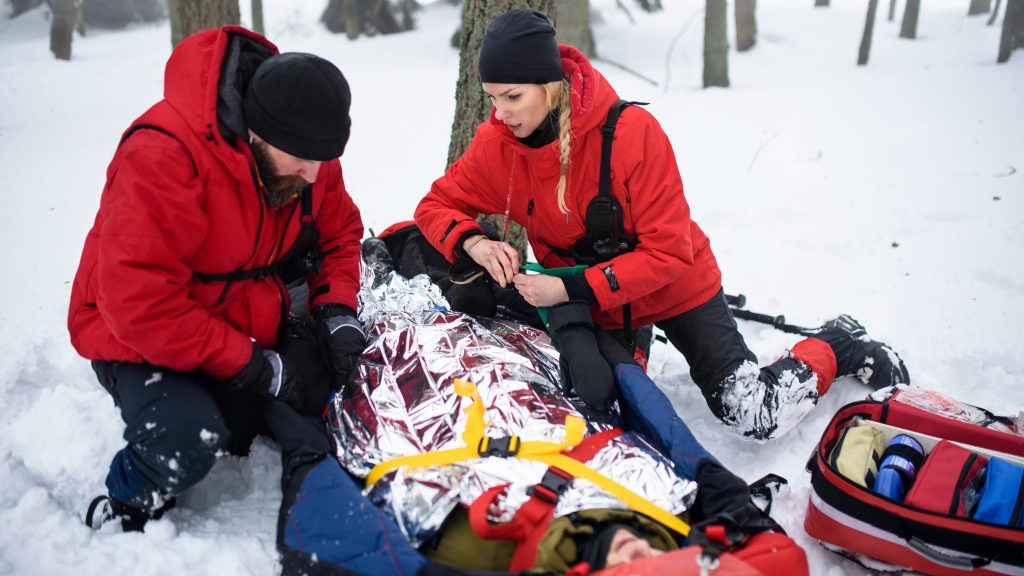
Pre-Made vs. DIY: Which Kit is Right for You?
When it comes to assembling a first aid kit, you have two main options: buying a pre-made kit or creating your own from scratch. Here’s a quick comparison:
| Feature | Pre-Made Kit | DIY Kit |
| Convenience | Ready to use out of the box | Requires planning and assembly |
| Cost | Varies; mid-range kits are affordable | Can be budget-friendly |
| Customisation | Limited, though some allow personalisation | Fully customisable |
| Quality | Depends on the brand, often reliable | Depends on the items you choose |
Recommendation:
If you’re new to first aid, starting with a reliable pre-made kit might be the easiest option. More experienced outdoors enthusiasts may prefer a DIY approach, allowing full control over each item in the kit.
Best First Aid Kits for Hiking and Wild Camping In the UK
Here are some top-rated kits ideal for hikers and wild campers in the UK, balancing essential features, lightweight designs, and durability.
1. Lifesystems Trek First Aid Kit
- Price: £18.00
- Weight: 240g
- Features: A popular choice among hikers, the Lifesystems Trek kit includes bandages, antiseptics, blister treatments, and an emergency whistle.
- Ideal For: Short hikes and single-night camping trips, compact enough for a small pack.
- Company Background: Lifesystems is known for creating outdoor-first products that hold up in rugged conditions, which makes them a favourite among UK campers.
2. Adventure Medical Kits Ultralight/Watertight .7
- Price: £25.00
- Weight: 180g
- Features: This kit is waterproof and ultra-light, ideal for those who need to save space and stay prepared. It includes wound care, pain relief, and blister treatment.
- Ideal For: Hikers who face wet or unpredictable weather conditions in the UK.
- Company Background: Adventure Medical Kits is a USA-based brand focused on wilderness survival and rescue, providing top-notch waterproof packaging.
3. Surviveware Small First Aid Kit
- Price: £32.00
- Weight: 550g
- Features: Comprehensive with 100 pieces, this kit offers the essentials and more, such as CPR equipment, a survival blanket, and additional room for customisation.
- Ideal For: Longer treks or multi-day camps where a wide array of supplies may be necessary.
- Company Background: Surviveware is celebrated for durable, well-organised first aid kits suitable for challenging environments.
How to Use Your First Aid Kits for Hiking and Wild Camping: Basic Emergency Tips
Knowing what’s in your kit is one thing, but knowing how to use it can make all the difference. Here are a few essential first aid skills to practice or review before heading out:
- Wound Care: Clean the wound with an antiseptic, apply gauze, and secure it with medical tape.
- Splinting and Bandaging: For sprains, use an elastic bandage to support the joint and prevent further injury.
- CPR: Basic CPR knowledge can save a life. Take a course or review basic CPR online.
- Dealing with Blisters: Clean, cover, and use blister pads before small irritations turn into painful sores.
- Handling Burns: Cool the area immediately, apply burn cream, and keep it covered with a clean bandage.
How to Maintain and Store Your First Aid Kits for Hiking and Wild Camping
To make sure your first aid kit stays in top shape, follow these maintenance tips:
- Restock after Every Trip: Replace used items like bandages and painkillers.
- Check Expiry Dates: Medications, antiseptics, and creams can expire—replace them as needed.
- Keep it Clean and Dry: Store your kit in a dry area, and consider a waterproof bag for extra protection.
Conclusion on First Aid Kits for Hiking and Wild Camping
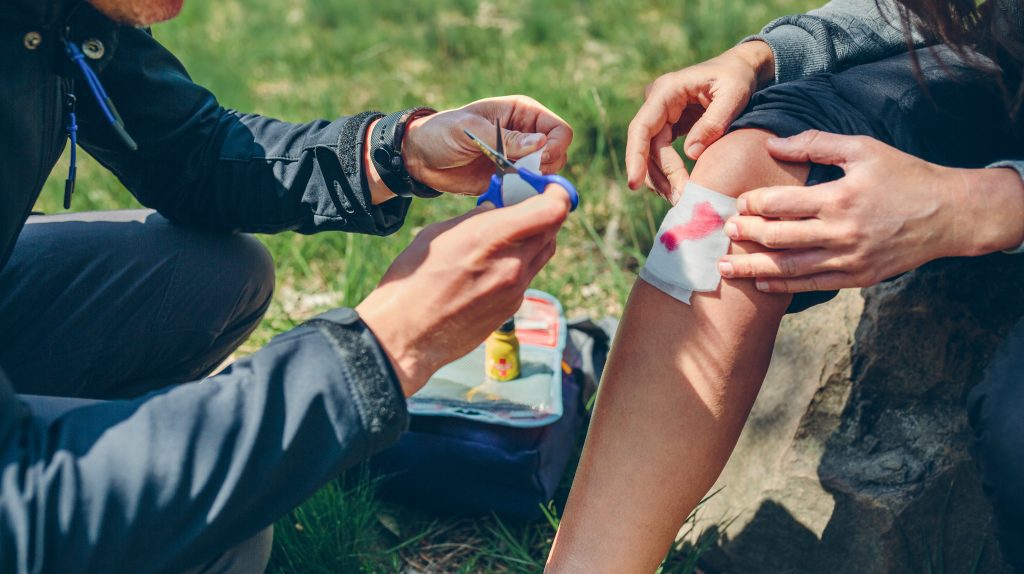
Having a first aid kit that’s well-stocked, lightweight, and tailored to hiking and camping in the UK is essential. It’s one of the simplest ways to add an extra layer of safety to your adventure, letting you focus on enjoying the journey rather than worrying about mishaps. So, grab a kit, learn some basics, and hit the trail with confidence!
Pairing your first aid kit with an Osprey backpack makes for a seamless setup on any hike or camping trip. Osprey’s quick-access pockets, durable compartments, and water-resistant features ensure your first aid kit stays safe, organised, and within easy reach when you need it most. For more on how an Osprey backpack can enhance your outdoor adventures, check out our Osprey Backpack Guide.
FAQs
1. What should I look for in a first aid kit for wild camping?
Look for compact size, waterproof packaging, and a good balance of essential items (like wound care and pain relief) and extras (like thermal blankets and blister treatments). Versatility and weight are especially important for wild camping, where space is at a premium.
2. Are pre-made first aid kits enough for hiking and wild camping?
Pre-made kits can be a great start, especially for new campers and hikers. They cover essential basics, but consider adding personal items and any medications you may need, like allergy treatments or extra blister care.
3. Can I make my own first aid kit?
Absolutely! Custom kits allow you to control the contents and often cost less. Ensure it includes key items like bandages, antiseptics, and personal medications, and keep it in a waterproof, durable case.
4. What’s the best way to handle blisters while hiking?
Cover blisters with blister pads or moleskin to reduce friction, and add a layer of tape if necessary. Keeping your feet dry and wearing proper hiking socks can help prevent them in the first place.
5. How should I store my first aid kit for hiking and camping?
Store your kit in a dry, accessible spot in your backpack, preferably in a waterproof bag or pouch. Restock it after each trip and periodically check the expiry dates on medications and antiseptics to keep it up-to-date.
With the right first aid kit, you can wander the UK’s wild landscapes with peace of mind, ready for whatever adventure—or mishap—comes your way.

